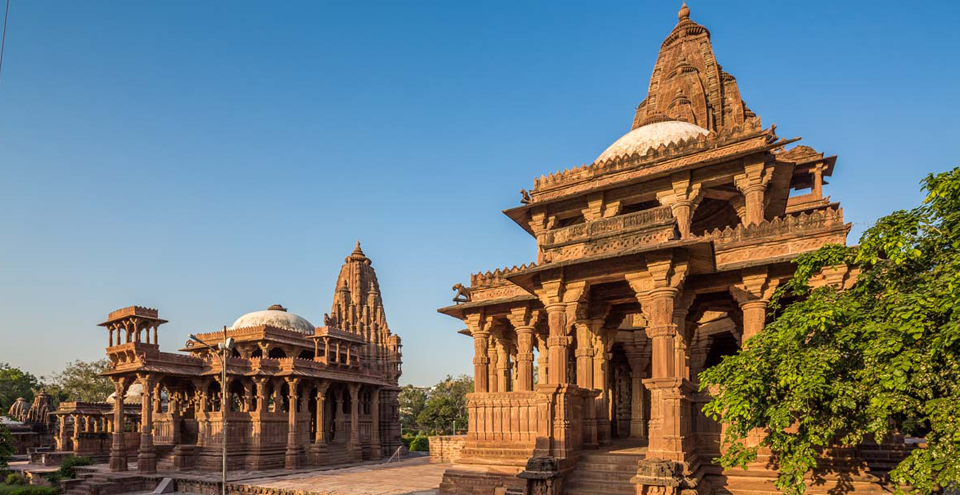
Mandore: The Historical Jewel of Jodhpur
Mandore, located near Jodhpur in Rajasthan, India, is an enchanting historical site renowned for its ancient temples, cenotaphs, and stunning architectural heritage. Often overshadowed by Jodhpur’s more famous landmarks, Mandore offers a unique glimpse into the rich history and culture of the Marwar region. In this blog post, we’ll explore the historical significance, key attractions, and visitor experience associated with Mandore.
Overview of Mandore
1. Location and Setting
Mandore is situated about 9 kilometers north of Jodhpur, making it a convenient day-trip destination from the city. The site is set amidst the arid landscape of Rajasthan, providing a serene backdrop of lush gardens and historical ruins against the rugged terrain.
2. Historical Significance
Marwar Heritage: Mandore was once the capital of the Marwar region before Jodhpur became the primary seat of power. The town served as an important center during the rule of the Rathore dynasty and boasts a rich historical and cultural legacy.
Royal Connections: Mandore is closely associated with the Rathore rulers, including Rao Jodha, the founder of Jodhpur. The site is home to various monuments dedicated to the Marwar royalty, including cenotaphs and temples.
Key Attractions in Mandore
1. Mandore Fort
Architectural Marvel: The Mandore Fort is an impressive structure that showcases the architectural prowess of the Rathore dynasty. The fort features a blend of Rajput and Mughal architectural styles, with intricately designed gateways and defensive walls.
Royal Palace: Within the fort, visitors can explore the remnants of the royal palace, which includes ornate rooms, courtyards, and historical artifacts. The palace offers a glimpse into the opulent lifestyle of the Marwar rulers.
2. Cenotaphs (Chhatris)
Cenotaph Complex: Mandore is renowned for its cenotaphs, or chhatris, which are elaborate memorials dedicated to the Marwar rulers and their families. The cenotaphs are adorned with exquisite carvings and intricate details, reflecting the grandeur of the Rathore dynasty.
Notable Chhatris: Key cenotaphs include those of Maharaja Ajit Singh and Maharaja Jaswant Singh, among others. Each cenotaph features unique architectural elements and artistic decorations, making them significant historical landmarks.
3. Mandore Gardens
Scenic Gardens: The Mandore Gardens surround the cenotaphs and offer a lush and peaceful environment for visitors. The gardens are well-maintained and feature a variety of flowering plants, trees, and water features.
Historical Monuments: The gardens also include several historical monuments, such as the Hall of Mirrors (Rang Mahal) and the Monument of the Dancing Girls, which add to the site’s charm.
4. Temples
Ancient Temples: Mandore is home to several ancient temples dedicated to Hindu deities, including the Mandore Temple and the Chamunda Mata Temple. These temples are known for their architectural beauty and religious significance.
Architectural Features: The temples feature traditional Rajasthani architectural styles, with intricately carved pillars, ornate sanctums, and beautifully designed entranceways.
Visiting Mandore
1. Accessibility
Travel: Mandore is easily accessible from Jodhpur, which is well-connected by road and rail. Visitors can reach Mandore by hiring a taxi or taking a local bus from Jodhpur. The nearest major airport is in Jodhpur, approximately 9 kilometers away.
Local Transportation: Within Mandore, local transportation options include auto-rickshaws and taxis. Exploring the gardens, fort, and cenotaphs can be done on foot or with the help of local guides.
2. Visiting Tips
Respect Local Customs: Mandore is a historical and cultural site, so it’s important to dress modestly and respect local customs. Avoid touching or climbing on the monuments, and follow any guidelines provided by local authorities.
Guided Tours: Hiring a local guide can enhance your visit by providing detailed insights into the history, architecture, and significance of Mandore. Guides can help navigate the site and offer valuable context for the various attractions.
Photography: Photography is generally allowed, but be mindful of any specific restrictions. Capture the beauty of the cenotaphs, temples, and gardens while respecting the site’s historical significance.
3. Best Time to Visit
Season: The best time to visit Mandore is from October to March, when the weather is cooler and more comfortable for outdoor exploration. This period offers pleasant temperatures and clear skies for sightseeing.
Avoiding Heat: The summer months (April to June) can be extremely hot, so visiting during the cooler season will provide a more enjoyable experience.
